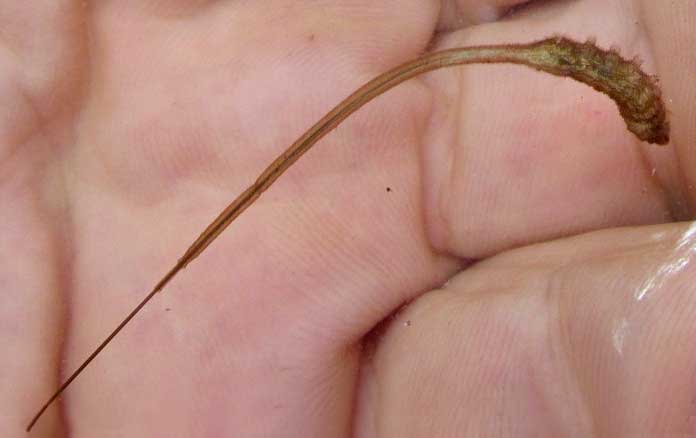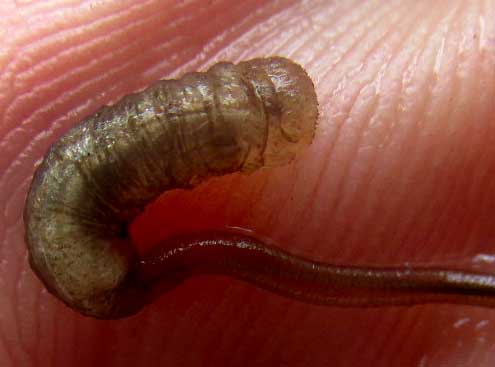Excerpts from Jim Conrad's
Naturalist Newsletter

from the January 17, 2016 Newsletter issued from Hacienda Chichen Resort beside Chichén Itzá Ruins, central Yucatán, MÉXICO
RAT-TAILED MAGGOT
Two or three weeks ago I stuck cut branches of Shrub Lantana and Mexican Sunflower into a jar of water, hoping the woody stems would develop roots. As days passed the stems got mushy, the water turned dark, and though the branches continued to look fresh a green, no roots formed. However, a wonderland of aquatic insect larvae spawned in the murky water. Mostly there were mosquito larvae, but also swimming, spiraling, wiggling, thrashing critters of the like I've not seen outside the tropics, and which I still can't identify and tell you about.
The most eye-catching creature, though, was something that does occur up North, but usually in such putrid, disreputable waters that most folks never see them or know about them. Above, you can see one from the jar, floating in my hand and about 2¼ inches long (6cm).
A close-up of the big end shows features we've observed in grubs, :

It's a Rat-tailed Maggot, the larva of a kind of hoverfly, a hoverfly being one of those innocent little flower-visiting flies that can hover in one spot. The ones I remember most from up North were yellow- and black-banded and often landed on sweating body parts, tickling the skin as they sopped up sweat with their round-ended mouthparts. Sometimes Rat-tailed Maggots turn up in birdbaths with water that hasn't been changed for awhile, and in rain gutters where water accumulates beneath leaves. Down here we have numerous hoverfly species, but I don't know which our Rat-tailed Maggot belongs to.
Rat-tailed Maggots are famous not only for their long tails but also because they can live in very oxygen-depleted waters thick with organic matter -- even saturated manure. This talent is possible because the tail is an extensible breathing siphon -- a snorkel -- through which the grub can breathe.
In the pot often I saw grubs anchor their thick front ends on degenerating plant stems an inch or two below the water, with their siphon tips extended to the water's surface, forming tiny dimples in the water's surface where air was being taken in. Other times the grubs swam through the water with swirling and jerking motions that would have looked clumsy had not the long tails, being somewhat stiff, waved about like conductor batons.
That long tail imparts such grace to the grub's movement that one can overlook that, in the end, we're dealing with what the English language disparages as a maggot.